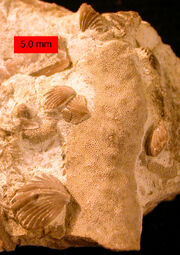
Zygospira modesta, spiriferid brachiopods, preserved in their original positions on a trepostome bryozoan; Cincinnatian (Upper Ordovician) of southeastern Indiana.
Paleoecology uses data from fossils and subfossils to reconstruct the ecosystems of the past. It includes the study of fossil organisms and their bromalites and other trace fossils in terms of their life cycle, their living interactions, their natural environment, their manner of death and burial. Paleoecology's aim is therefore to build the most detailed model possible of the life environment of those living organisms found today as fossils; such reconstruction work involves complex interactions among environmental factors (temperature, food supplies, degree of solar illumination, etc.). Of course, much of this complex data has been distorted or destroyed by the post-mortem fossilization processes, adding another layer of complexity.
The environmental complexity factor is normally tackled through statistical analysis of the available numerical data (quantitative paleontology or paleostatistics), while the study of post-mortem processes is known as the field of taphonomy.
Much paleoecological research focuses on the last two million years (the Quaternary period) because older environments are less well-represented in the fossil timeline of evolution. Indeed, many studies concentrate on the Holocene epoch (the last 11,000 years), or the last glacial stage of the Pleistocene epoch (the Wisconsin/Weichsel/Devensian/Würm glaciation of the ice age, from 50,000 to 10,000 years ago). Such studies are useful for understanding the dynamics of ecosystem change and for reconstructing pre-industrialization ecosystems. Many public policy decision-makers have pointed to the importance of using paleoecological studies as a basis for choices made in conservation ecology.
See also[]
- Palaeogeography
External links[]
- Fox, D. Dig Deeper. Conservation in Practice 7(3):15-21.
- Taylor, P.D. and Wilson, M.A., 2003. Palaeoecology and evolution of marine hard substrate communities. Earth-Science Reviews 62: 1-103. [1]